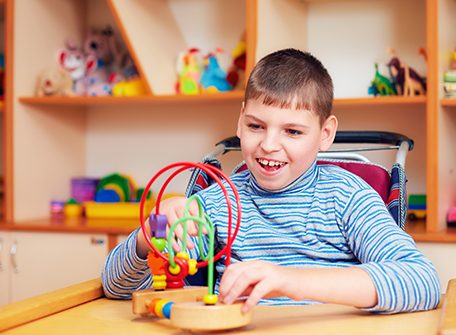Cerebral palsy is a collection of neurological illnesses that begin in infancy or early childhood and impact bodily movement and muscle coordination for the rest of one’s life. Damage to or abnormalities in the developing brain creates cerebral palsy (CP), which impairs the brain’s capacity to control movement, maintain posture, and balance. The term cerebral relates to the brain, while palsy means loss or impairment of motor function.
Cerebral palsy affects the motor portion of the brain’s outer layer (also known as the cerebral cortex), which controls muscular movement. The cerebral motor cortex hasn’t formed normally in some situations throughout fetal development. In many studies, it is shown that intensive therapy is highly effective for children with cerebral palsy and other neurological disorders.
Children With Cerebral Palsy Have A Wide Range Of Symptoms, Including:
- Ataxia refers to a lack of muscle coordination when performing voluntary motions.
- Spasticity is characterized by stiff or tight muscles and excessive reflexes.
- A loss of strength in one or more arms or legs;
- A “scissored” stride, walking on one’s toes, or a crouching motion;
- The muscular tone that is either overly tight or too loose;
- Excessive drooling or swallowing or speaking difficulties
- Tremors (shaking) or uncontrollable motions;
- Delays in completing milestones in motor skills; and
- Precise actions, such as writing or buttoning a shirt, are difficult.
Is It Possible To Prevent Cerebral Palsy?
Although cerebral palsy caused by genetic defects cannot be avoided, some risk factors for congenital cerebral palsy can be managed or avoided. Rubella, often known as German measles, can be avoided if women are vaccinated against it before becoming pregnant. Early in pregnancy, Rh incompatibility can also be controlled. Acquired cerebral palsy, which is frequently caused by a head injury, can easily be avoided by following basic safety precautions, such as utilizing car seats for infants and toddlers.
What Is The Treatment For Cerebral Palsy?
Although cerebral palsy cannot be cured, treatment can significantly improve a child’s abilities. If their disabilities are adequately treated, many children grow on to live near-normal adult lives. In general, the younger children receive treatment, the better their chances of overcoming developmental problems or learning new ways to do tasks that are difficult for them.
There is no one-size-fits-all therapy for those with cerebral palsy. A team of health care professionals will work with a child and his or her parents to identify specific impairments and needs, and then develop an appropriate plan to address the core disabilities that affect the child’s quality of life, once the diagnosis has been made and the type of CP has been determined.
Intensive Physical therapy is a cornerstone of CP treatment, and it is usually started in the first few years of life or shortly after the diagnosis is made. Specific exercises and activities can help maintain or enhance muscle strength, balance, and motor abilities, as well as prevent contractures. To enhance mobility and stretch spastic muscles, special braces (called orthotic devices) might be utilized.
Occupational Therapy- focuses on maximizing a child’s mobility, improving upper body function, and improving posture. Occupational therapists assist people in finding new ways to deal with everyday tasks including dressing, going to school, and participating in daily activities.
Speech and Language Therapy- can help a child learn new ways to communicate, such as using sign language and/or special communication devices like a computer with a voice synthesizer, or a special board covered with symbols of everyday objects and activities to which a child can point to indicate his or her wishes.
Feeding Therapy– When children with CP have difficulties eating and drinking due to a lack of control over the muscles that move their mouth, jaw, and tongue, feeding and drooling treatments are frequently required. They’re also vulnerable to inhaling food or liquid, as well as starvation, recurring lung infections, and progressive lung disease.
Where To Find Help?
Hope AMC, is Dubai’s one of the top pediatric rehabilitation centers. We offer intensive therapy programs for children with neurological disorders in Dubai. Our three weeks intensive therapy program is a fine combination of Occupational Therapy, Physical Therapy, Feeding Therapy, and Speech and Language Therapy.
We think that each child is unique, as are his or her needs, and that’s why our programs are tailored to their specific needs and aspirations. The length of the therapy, the severity of the therapy, and the instruments and techniques employed in the therapy all differ from child to child.
Conclusion
Intensive Physiotherapy Program produces faster and better outcomes. Many children with cerebral palsy and other neurological abnormalities progress to the next level of developmental skills considerably faster than expected during the 3-week program.
Click here to discuss your child’s specific condition and get the best treatment solution from our experts.


